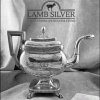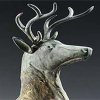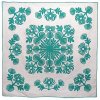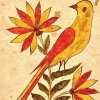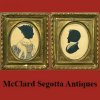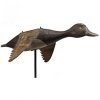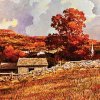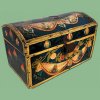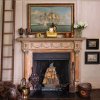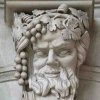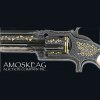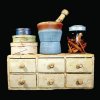Records Fall at Copley Summer Sale
July 28th, 2017
Copley Fine Art Auctions, Plymouth, Massachusetts
Photos courtesy Copley Fine Art Auctions
By the time auctioneer Peter J. Coccoluto got to lot eight on the first day of Copley Fine Art Auctions’ July 27 and 28 sale in Plymouth, Massachusetts, two world records had been achieved. And it just went on from there. No fewer than 19 world records were broken. The two-day sale led with the collection of conservationist Donal Clare O’Brien Jr. (1934-2013), whose collection of American decoys and sporting art was gathered over six decades and is considered by many to be the finest such collection ever. Some examples never had been sold publicly until now. The sale was yet another record for Copley, bringing $4.8 million (with buyers’ premiums).
The July 26 preview cocktail party was packed, and the quality of the decoys and art drew a full house for both days. The 156-lot O’Brien decoy and sporting art collection was a white glove sale, with 100% sold. Each bird bore the O’Brien collection stamp, a silhouette of a Ward brothers 1936 canvasback. Most birds sold well in excess of their estimates, with an overall average price of $27,000 per decoy, breaking the average price per lot record of the 2000 sale of the collection of Dr. James M. McCleery. The sale of the O’Brien collection was the most successful decoy auction of all time. The entire two-day sale was 92% sold by lot.

The Barber-O’Brien ruddy duck, circa 1895, by Lee Dudley (1860-1942) of Knotts Island, North Carolina, is considered by experts such as Adele Earnest, William J. Mackey Jr., and Joel Barber, among others, to be the very best of its kind. Mackey, in his American Bird Decoys, wrote “…the heads on Dudley’s decoys are the finest the writer has ever seen.” Bidding on the bird opened at $65,000 and ended when a collector in the gallery took it for $234,000 (est. $80,000/120,000). As soon as the bird was pronounced “sold,” collectors and the trade milled around the successful bidder to congratulate him. The bird retains the Dudley “L D” brand and O’Brien’s collection stamp. When Dudley first created ruddy duck decoys, he sold them for five cents per bird. Provenance includes Lee Dudley’s rig that he sold in 1913 to the Knotts Island Gunning Club for 50 cents apiece, the Joel Barber collection (circa 1925), and the Thomas Marshall collection. Additionally, it has been published and illustrated widely. The Copley sale is the first time this bird and a number of others from O’Brien’s collection had been offered for public sale.

O’Brien considered this McCleery-Ward canvasback drake and hen by the Crisfield, Maryland, brothers (and barbers by training) Lemuel T. Ward (1896-1984) and Stephen Ward (1895-1976) the essence of the art of decoy making. Stephen carved and Lemuel painted, with enviable results. The birds are inscribed on the bottom “1932 / made by Steve / painted by Lem / Ward Bros. / Crisfield, Md.” They are also stamped “McCLEERY.” O’Brien and his family selected the canvasback hen as the icon of the collection. Each was estimated at $20,000/30,000; the hen sold for $84,000 on the phone, a record for the species, and the drake sold for $72,000.

This widgeon drake by Philadelphia carver John Blair Sr. (1842-1928) is exceptional. This form is the most desirable of the Philadelphia school of carving. In his early career as a wheelwright and carriage maker, Blair’s carriages and sleighs were highly desirable. He retired as a gentleman farmer to hunt and fish. The widgeon is branded “G. Strickler” and stamped “SGH” twice for Delaware author and collector Somers G. Headley, whose favorite bird it was. It sold on the phone for $102,000 (est. $50,000/70,000).
If the name seems familiar, that’s because Donal Clare O’Brien was an uncle to Stephen B. O’Brien, a fourth-generation sportsman himself, and it’s a sporting family. It must be in the genes; Stephen B. O’Brien Jr.’s father, also Stephen B. O’Brien, is a dedicated sportsman. The auction was very much a family affair, with plenty of O’Briens on hand, including Donal’s widow, Katharine, also an ardent conservationist, and several of their children. Donal O’Brien was a devoted family man, an artist with a good eye, a carver, a collector, a dog trainer, and by day a lawyer for the Rockefeller family—for five decades. He also was on the board of the National Audubon Society for 25 years (chairman for 15). His carvings of puffins placed along the shore helped restore the Atlantic puffin to the Maine coast after a 100-year absence. As he got deeper and deeper into conservation, his interest in hunting waned. Of his uncle, auctioneer and conservationist Stephen B. O’Brien Jr. said simply, “He was a great person to have in my life.”
Another decoy family with a large presence at the sale was the McNair family. Carver Mark S. McNair (b. 1950) exhibited and sold his carvings during the three-day dealer exhibition; a group of his birds also sold in the auction. His son Colin is the decoy specialist at Copley and a carver; another son, Ian, is a full-time carver; both worked the phones for the sale. To round out the family is patriarch Mervin F. Roberts, age 95. Roberts is the author of some 40 books and booklets on natural history. A visit to his website is well worth a reader’s time (www.mervinfroberts.com/mervin-f-roberts). Roberts told M.A.D. that he loves the Copley sales.
The auction catalogs (there are two) are keepers. They have extensive documentation and illustrations of each object; some of the entries run to three pages. It is worth the read for any collector of any art.
Just before the start of the first day, auctioneer Peter J. Coccoluto advised us to settle in for a long sale. With only 156 lots (day one), one might expect the sale to run two or two and a half hours. High interest in O’Brien’s collection made for a long but rewarding day.

The highlight of the Donal O’Brien collection was the Thomas Chambers (1860-1948) wood duck drake, which is considered by many experts to be the finest Canadian decoy known. The circa 1900 bird is one of two wood ducks by the Wallaceburg, Ontario, carver and is in better condition than the other. At a final price of $270,000 (est. $80,000/120,000), the bird achieved a record for a Chambers carving and the record for any Canadian maker. Stephen B. O’Brien Jr. described it as “a national treasure.”
The highlight of the O’Brien collection was a Thomas Chambers (1860-1948) wood duck drake that is considered by many experts to be the finest Canadian decoy known. The circa 1900 bird is one of two wood ducks by the Wallaceburg, Ontario, carver, and it is in better condition than the other. At a final price of $270,000 (est. $80,000/120,000), the bird achieved a record for a Chambers carving and the record for any Canadian maker. Stephen O’Brien described it as “a national treasure.” It retains the original paint, with minor gunning wear, and had been part of the George M. Hendrie rig; Hendrie was a member of the St. Clair Flats Shooting Company, and Chambers was its manager. It came to Donal O’Brien’s collection around 1978 from the Ronald Swanson collection. It has been published widely, and it was exhibited in the 1981 show The Art of the American Decoy: Folk Sculpture from the Collection of Mr. and Mrs. Donal C. O’Brien Jr., an exhibition of 73 of Donal O’Brien’s classic decoys at the Museum of American Folk Art (now the American Folk Art Museum). Catalog notes indicate that the wood duck, along with a dovetailed Canada goose, occupied prime positions in O’Brien’s den.

This pintail drake by Florence, New Jersey, carver John English (1852-1915) reportedly was situated prominently in the Donal O’Brien home. It is the only “pure” English pintail; others exist but were repainted by John Dawson (1886-1959), while this example was painted by English. It is also the only English drake in original paint. After a lively phone competition, the bird brought a record $246,000 in the gallery. The estimate was $80,000/120,000. It is headed to a major Atlantic seaboard collection. Mascolo photo.
 A pintail drake by Florence, New Jersey, carver John English (1852-1915) was also situated prominently in the O’Brien home. It is the “only pure English pintail”; others exist but were repainted by John Dawson (1886-1959), while the example at hand was painted by English. It is also the only English drake in original paint. After a lively phone competition, the bird brought $246,000 (est. $80,000/120,000) in the gallery. It is headed to a major Atlantic seaboard collection. The price is a record for a Delaware River region decoy. English is known as the innovator of the Delaware River decoy, and this example is perhaps the most important pintail to come to market. It had come from the Lloyd Johnson collection to Morton M. Hanson and finally to O’Brien.
A pintail drake by Florence, New Jersey, carver John English (1852-1915) was also situated prominently in the O’Brien home. It is the “only pure English pintail”; others exist but were repainted by John Dawson (1886-1959), while the example at hand was painted by English. It is also the only English drake in original paint. After a lively phone competition, the bird brought $246,000 (est. $80,000/120,000) in the gallery. It is headed to a major Atlantic seaboard collection. The price is a record for a Delaware River region decoy. English is known as the innovator of the Delaware River decoy, and this example is perhaps the most important pintail to come to market. It had come from the Lloyd Johnson collection to Morton M. Hanson and finally to O’Brien.
Lee Dudley carved a redhead drake with fine detail to the head and a smooth humpback, circa 1890, for his personal gunning rig. It, too, is prized. Estimated at $20,000/40,000, it brought $66,000.
Virginian Partridge (No. 16, Plate LXXVI), an 1830 hand-colored engraving, 25 5/8" x 38¼", “Drawn from Nature and Published by John James Audubon” (1785-1851), was “Engraved, Printed and Coloured by R. Havell.” O’Brien bought it at Sotheby’s in January 1985. Estimated at $10,000/20,000, it realized $63,000.

The highlight of day two was this gouache and watercolor, Supper in Camp, 1901, by Arthur Burdett Frost (1851-1928). The picture is a highly detailed depiction of three men at a campfire, two of whom observe while the third does the cooking. It’s the kind of painting that reveals additional details the longer one observes it. Frost was colorblind, and the nearly monochromatic image is very subtle. Estimated at $70,000/90,000, the picture brought $168,000, a world record for a Frost gouache.
Bay Snipe Shooting, a watercolor and gouache en grisaille by Arthur Burdett Frost (1851-1928), was signed and dated 1900. It is a nearly monochromatic and detailed depiction of two hunters in a blind in a marsh, with their bag of birds behind them. Frost’s colorblindness accounts for his monochromatic style. Estimated at $30,000/50,000, the painting sold for $75,000.
Decoys and sporting art from other collections were auctioned off on day two of the sale. It began with 16 lots of decoys by Mark S. McNair (b. 1950) of Craddockville, Virginia, the highlight of which was a 21½" long cormorant. The bird was incised “McNair” and dated 1989 and bore the inscription, “I’m very pleased with this—it represents a transformation that I find very exciting.” The bird came from the Barrie and Bernice Stavis collection to a private collection. It realized $3600 (est. $1400/1800).

The Mackey-Wheeler goose, circa 1935, by Stratford, Connecticut, carver Charles Edward Wheeler (1872-1949), better known as “Shang” Wheeler, is described in the sale catalog as “the grandest Connecticut decoy known,” unique in form and paint. It is 30" long, 4" longer than Wheeler’s other geese. It is exceptionally carved, with crisp wings and a separation of the wings along the back. It retains the William J. Mackey Jr. collection stamp, has been published widely, and was exhibited with O’Brien’s collection at the Museum of American Folk Art (now the American Folk Art Museum). Estimated at $80,000/120,000, it sold on the phone for $198,000, a record for the carver and for a Connecticut carving. Mascolo photo.

The “dust jacket” turned-head black-bellied plover carved around 1900 by Anthony Elmer Crowell (1862-1952) of East Harwich, Massachusetts, is remarkable for its form and detail. Decoy authority William J. Mackey Jr. described the bird, with its turned head and fine detail, as “Elmer Crowell at his best.” The bird, with two rigmates, was part of the cover image of the dust jacket on Mackey’s book American Bird Decoys. The underside is stamped “C. W. Loud” and bears the Mackey collection ink stamp. The bird sold for $174,000 (est. $125,000/175,000). Its provenance includes the Mackey collection and that of J. William Middendorf, former U.S. secretary of the navy, before it was in the O’Brien collection. It has been published extensively.
A 10" long rigmate pair of golden plovers, circa 1900, by Accord, Massachusetts, carver Joseph W. Lincoln (1859-1938), described as one of the best Lincoln pairs to come to market, was estimated at $5000/8000, and it sold for $14,400.
For more information, call (617) 536-0030 or see (www.copleyart.com).

Lothrop Turner Holmes (1824-1899) of Kingston, Massachusetts, carved this ruddy turnstone in about 1855. He had worked pouring molten iron in foundries before he turned to carving. He was among the earliest shorebird carvers, and he carved decoys for his own rig. They are considered rare, as only three or four are known, and they are prized. This bird sold for $102,000 (est. $40,000/60,000). The bird has a fine publishing history, including in Gwladys Hopkins’s Massachusetts Masterpieces: The Decoy as Art (2016).

Down’s Gulch, this 24" x 36" oil on canvas by Donal O’Brien Jr.’s friend Ogden Minton Pleissner (1905-1983), depicts three figures in a canoe, one fishing, another grabbing the net, and the third poling. The painting realized $84,000 (est. $80,000/120,000).

This running golden plover from about 1890 was made by either Charles Sumner Bunn (1865-1952) of the Shinnecock Reservation in New York or by William Bowman (1824-1906) of Bangor, Maine, and Lawrence, New York. The bird was estimated at $20,000/30,000, and it sold for $48,000. Its provenance includes the Russell B. Aitken collection and the Grant Nelson collection.

This 14½" long preening goldeneye drake by Anthony Elmer Crowell (1862-1952) of East Harwich, Massachusetts, was carved in 1914, around the time he transitioned from carving working decoys to creating decorative carvings. This is an early example of his so-called “mantel” carvings. It sold for $90,000 (est. $70,000/80,000).
Originally published in the October 2017 issue of Maine Antique Digest. © 2017 Maine Antique Digest


